Sedans – which used to be the best-selling vehicles – have become a harder sell since the early 2000s, chiefly because crossovers (and SUVs) offer the roominess and practicality that used to sell sedans, plus the usually available AWD or 4WD that makes crossovers and SUVs better able to deal with poor weather.
So Honda decided to sell something most of crossover and SUVs lack.
Phenomenal gas mileage.
Plus something every EV lacks.
Phenomenal range.
The just redesigned Accord hybrid (which is now most Accords; stay tuned) goes more than 50 miles on a gallon of gas in city driving – and can take you almost 700 miles before it needs more gas.
Good luck finding a crossover or SUV – much less an EV – that can do that.
On top of that, it also has a roomy trunk (and plenty of room in back).
What It Is
The Accord is Honda’s mid-sized sedan. It – and primary rival Toyota Corolla – were for many years the most popular, best-selling cars on the market.
Until crossovers and SUVs ate into their sales.
Unlike the Camry – which you can still get with a V6 – the Accord is now only available with four cylinder engines. One of them is combo’d up with a hybrid drivetrain – and that’s the one that can go more than 50 miles on a gallon of gas (and more than 650 miles on a tank).
The Camry also offers a hybrid drivetrain and it also goes more than 50 miles on a gallon – but Toyota only offers the hybrid set-up in one (“hybrid”) trim that isn’t very sporty.
Honda offers its hybrid drivetrain in four different Accord trims, each with its own character.
Prices start at $31,345 for the Sport, which comes standard with a 19 inch wheel/tire package, plus heated seats, an upgraded eight speaker audio system and a larger (12.3 inch) LCD touchscreen.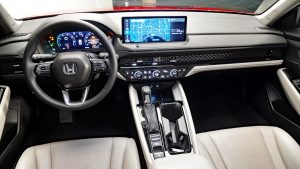
The $32,990 EX-L hybrid reverts to 17 inch wheels (for maximum mileage; stay tuned for that) and gets leather-covered heated front seats.
The $33,325 Sport-L combines the Sport’s 19 inch wheel/tire package with the EX-L’s heated leather seats.
A top-of-the-line Touring trim also has the more aggressive 19-inch wheels and shorter-sidewall tires plus heated rear seats, coolers for the front seats, a premium 12 speaker audio system, rain-sensing wipers and Google voice-assistant.
It stickers for $37,890.
What’s New For 2023
The Accord is heavily updated – and the hybrid lineup expanded. In fact, only two of the Accord’s six available trims – the base LX and the next-up EX- aren’t hybrids. Part of the reason for this has to do with federal fuel economy standards, which are slated to increase to . . . just shy of 50 MPG by 2026.
By making most Accords hybrids, Honda will not have to worry about being socked with fines for making cars that fall short of that standard.
What’s Good
Goes very far on a gallon – and very long in between refills.
Significantly more backseat legroom than Camry hybrid.
Quicker than Camry hybrid.
What’s Not So Good
Much pricier than Camry hybrid, which starts at just $28,655.
Four cylinder-only.
Front-wheel-drive-only.
The Accord used to be available with either a (standard) four cylinder engine or (optionally) a V6 engine. It is currently available with your pick of four cylinder engines.
You can thank the government for that (see that bit above about the feds demanding every new car average nearly 50 MPG by 2026; you can’t do that with a V6).
The standard 1.5 liter (turbocharged) four makes 192 horsepower and the same 192 ft.-lbs. of torque. It’s paired with a CVT automatic and the combo touts 29 miles-per-gallon in city driving and 32 on the highway. This is the standard – and only – combination available in the base LX and next-up EX trims.
All the other Accord trims (Sport, EX-L, Sport-L and Touring) come standard with larger 2.0 liter four – not turbocharged – that’s paired with a dual-motor hybrid system for a combined peak output of 204 horsepower, which interestingly – is almost exactly the same power made by the 1.5 liter turbocharged four that powers the high-performance version of the Honda Civic Si.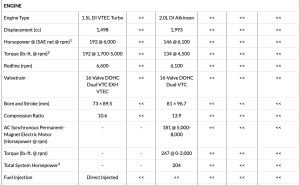
It’s interesting – because the Accord hybrid’s powertrain enables the larger (mid-sized) Accord to go 51 miles (in city driving; 44 on the highway) on a gallon of gas whereas the smaller (compact-sized Civic Si only goes 27 miles on a gallon in city driving (37 on the highway).
Of course, the Civic Si is quick – being focused on quickness. It gets to 60 in about 6.6 seconds; but you might be interested to discover that the mid-sized Accord hybrid gets to 60 just as quickly.
And it goes a lot farther.
On a full tank of just 13 gallons of gas, the hybrid Accord can go 652 miles (in city driving; 563 on the highway) before it needs more gas. The typical driver might only need to get gas twice a month.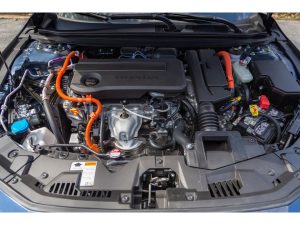
This is also much farther than any available EV can go before it needs more charge.
And it’s also more than that – in that while hybrids (like EVs) have a battery pack, a hybrid’s battery pack leads an easier life because it is never heavily discharged; the gas engine serves the dual purpose of propelling the vehicle and generating electricity as-you-drive, to power up the battery pack. And because it isn’t solely responsible for powering the vehicle. That’s why hybrid battery packs rarely begin to lose their capacity to retain charge until the hybrid has been on the road for 12-15 years or even longer – while EV battery packs tend to lose their charge-holding capacity sooner unless you avoid discharging them heavily, regularly. Of course, that greatly limits the useful driving range of the EV, which hasn’t got that much range to start with.
Catch meet 22.
The only hair in the soup is that the hybrid Accord’s engine is optimized to burn 91 octane premium fuel, due to its high (13.9:1) compression ratio. This adds 30-40 cents to the cost of a gallon of gas.
Driving the hybrid Accord is such a contrast vs. driving the electric Genesis GV60 I was driving the week prior (more here) in that I wasn’t able to drive the GV60 much – or far – because it rapidly ran out of range and because it took a long time to charge (in part because I was unable to “fast” charge it).
I’ve been driving the Accord for going on a week now – and it still has several hundred miles of range left. A round-trip drive of 60 miles – which for me is into town and back home – consumes less than two gallons of gas. You have 13 gallons of gas if the tank’s full to start with.
That works out to so much range you rarely have to think about stopping to get more. Or worrying that you won’t be able to get it when you need it.
And yet it drives a lot like an EV in that it is extremely quiet – until you decide to make some noise. The kind EVs can’t make – at least, not naturally. The sound of an engine revving, when you floor the accelerator. Honda knows how to make engines that sound great when they’re revving – and that’s the case here. Much more so than is the case with the hybrid version of Toyota’s Camry, which goes farther on a gallon (51 city, 53 highway) but takes a full second longer to get to 60 and which doesn’t seem especially enthusiastic about getting you there.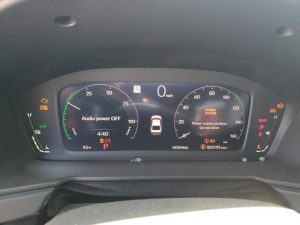
The only downside – as regards the Accord – is you don’t get a tach to watch the progression of the the revving. Instead, there’s a tach-emulating power-charge gauge in place of the tach, to the left of the speedometer. There’s also a novel take on the gas gauge that’s to the right of the speedometer: To the left of the power-charge gauge is a battery-charge gauge – though it’s kind of superfluous in that the Accord’s hybrid battery never reaches empty.
But you can see how close to full it is.
One misses the V6 that used to be available optionally in the Accord (and which is still available in the Camry, optionally) but the overall package is still appealing because it’s different. Economical – and sporty.
The Camry hybrid’s economical.
The Accord is still considered a mid-sized sedan but it’s a few inches closer to being full-sized now. The prior model was 192.2 inches long. The ’23 is 195.7 inches long. That’s also several inches longer than the Camry (192.1 inches) and another contender in the class, the Kia K5 sedan (193.1 inches).
The additional length makes the Accord look like the larger car it is – and looks are more than just skin deep, too.
The Accord has the most rearseat legroom (40.8 inches) of the three and (once again) by several inches. The Camry’s got 38 inches of rearseat legroom and the K5 – which isn’t available as a hybrid – only has 35.2 inches.
Another practical attribute the Honda boasts is a 16 cubic foot trunk – vs. the Camry’s slightly smaller 15.1 cubic foot trunk.
The fact that the Accord is roomier – and so more practical – than the Camry is an interesting historical turnabout in that, historically, the Camry has until recently been the more practical (and less of a looker) model in the class. It’s now more of a looker. But you may not like its more aggressive look – and by the numbers, it’s no longer the most practical model in the class.
With its family-friendlier back seats and trunk, that honor goes to the new Accord.
Other practical things about the Accord that deserve to be mentioned include the retention of physical (knob) controls to allow the adjustment of AC/heat and fan speed by feel, without needing to take one’s eyes off the road to scroll through a menu or find the right spot on a touchscreen to tap. There is a touchscreen, but it’s mostly informational. The things you regularly need to do while you’re driving don’t need to be done via the touchscreen.
Another small but functionally important thing is the way the vents are designed. It’s an interesting design, too.
Instead of the usual vertical/horizontal “box” type vents that let you direct airflow to the left or the right or up and down (but almost never both, due to the mechanical limitations of the “box” type design) you get an aircraft-type ball design, without the ball. The airflow vent extends most of the length of the dash and along the way there are small adjustment toggles protruding that you can use to fine-tune the airflow in any direction you like.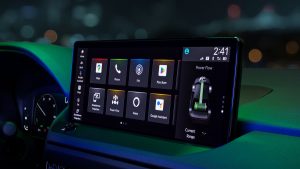
It is small but significant details such as these that make the Accord a very pleasant place to spend time in, whether you’re behind the wheel or sitting in back.
The Rest
One thing Honda might have done but decided not to – at least for now – is to offer a lower-cost version of the hybrid Accord. As things stand, you get more performance (vs. Camry hybrid) for your money, along with phenomenal economy. But Camry has the advantage when it comes to economy – because it’s significantly more affordable.
It is even more so when you take into account the fact that the least-expensive version of the Accord hybrid – the $31,345 Sport H – isn’t the most economical version of the Accord hybrid – probably because it comes standard with larger (19 inch) wheels and tires that weigh more and add rolling resistance. This version of the Accord hybrid only returns 46 MPG in city driving and 41 on the highway.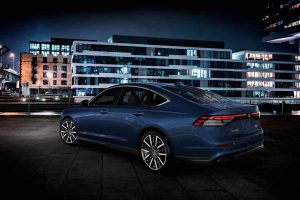
To get an Accord hybrid that rates 51 city/44 highway, it is necessary to buy at least an EX-L trim, which stickers for $32,990 to start. That amounts to a difference of $4,335 vs. the cost o a Camry hybrid ($28,655).
The other thing Honda hasn’t done – yet – is to offer all-wheel-drive, which both the Camry and the Kia K5 do. The Kia also offers a much more powerful (290 horsepower) engine as an option; the Camry still offers an even more powerful (301 horsepower) V6 – although that engine is not available with AWD.
The Bottom Line
Honda knows what’s coming – and has already gotten ready for it. Come 2026, the federal government will require all new vehicles to average close to 50 MPG.
The ’23 Accord already does.
. . .
If you like what you’ve found here please consider supporting EPautos.
We depend on you to keep the wheels turning!
Our donate button is here.
If you prefer not to use PayPal, our mailing address is:
EPautos
721 Hummingbird Lane SE
Copper Hill, VA 24079
PS: Get an EPautos magnet or sticker or coaster in return for a $20 or more one-time donation or a $10 or more monthly recurring donation. (Please be sure to tell us you want a magnet or sticker or coaster – and also, provide an address, so we know where to mail the thing!)
If you like items like the Keeeeeeev T shirt pictured below, you can find that and more at the EPautos store!





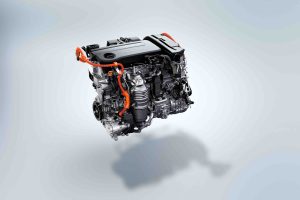
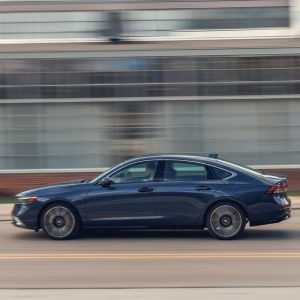
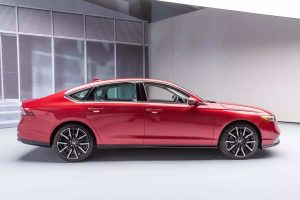







I’ve read the 2016 V6 Honda Accord manual coupe was a stealthy, fun muscle car. And the last of its kind. Maybe I’ll find out one day. Nice review, nice car. I’ve ridden in a few on Lyft rides. They’re fine. Huge digital central speedometer.
Hi Mark,
The Accord V6 – and the V6 Camry – were among the bet stealth performance cars ever made. The Camry V6 is quicker to 60 (just over 5 seconds) than almost all classic V8 muscle cars – and faster, too. But it doesn’t look it – and that lets you use it!
Hey Eric,
Longer term (10-15 years out), what do you think will end up being more reliable, a turbo or a hybrid?
Hi Rich,
That’s a really good question… If history is any guide, the hybrid will last longer and be more reliable for longer. The Prius has been around 20 years now and many that are 12-plus years old are still in regular service as daily drivers. They are popular among taxi drivers, who rack up a lot of miles.
Hybrids have several longevity upsides. The first being their battery pack is never heavily discharged (heavy discharging is hard on batteries) and is kept “topped off” by the engine. Second, the battery is only part of the drivetrain; it is not the sole source of propulsive power – and so leads an easier life. Third, the engine in most hybrids is not turbocharged, so it is under less pressure (literally).
Hybrid batteries, when they do need to be replaced, are also not absurdly expensive to replace, relative to the value of the vehicle.
The Accord is a nice hybrid…..
Here is a very high fuel economy hybrid from 2013……..
Instead of buying 25 mpg 5000 lb EV’s people should drive these……
Why the VW XL1 was a 300mpg Bugatti Veyron. Hypermiling Hybrid Hypercar review.
Why the Volkswagen XL1 was the Veyron of eco cars.
10 liter…2.6 gallon gas tank…range 800 miles….refuel in 20 seconds….300 mpg…during testing they got 340 mpg….best fuel economy in history….
to maintain 60 mph requires only 8.3 hp….designed for long distance driving or short commutes….curb weight about 1600 lb….
2013 VW XL1 new price about $122,000…..most recent used price the same…no depreciation….
after ten years an EV has about 100% depreciation….because it needs a $22,000 battery….
https://www.youtube.com/watch?v=R_xxF0v1Yrs
HUGE News! Honda CEO Shocks All EV Car Makers!
Honda CEO’s latest announcement left the automotive industry in disbelief. CEO Toshihiro Mibe just made a bold statement about the direction in which Honda is headed, and how it’s avoiding the EV race. He praised combustion engines and believes that Honda will continue producing internal combustion engine cars until 2040 at the very least.
https://www.youtube.com/watch?v=tA0onXi4e34
An Accord is a nice new car, for sure. Honda won’t steer you wrong.
Bought new back in 2012, decided to buy a brand new Pathfinder, it has done a good job, maintenance, oil changes, some new parts, been a good vehicle. I would recommend a Nissan product that has a V6 engine, gotta have four-wheel drive.
You have to research the choices before deciding what to buy.
I don’t regret the decision to buy a Pathfinder, not disappointed in any way.
Hi Drump,
Both Honda and Toyota are companies that until rather recently were like Ford was back in the ’20s and ’30s when Henry Ford was still around (and his sons becoming involved in running the company). These outfits cared because it was their family name on the radiator- so to speak. GM stopped caring about cars decades ago. It might as well sell appliances. Hey, that’s just what it does sell these days!
Eric,
William Durant built GM. There is a rest of the story.
“While U.S. banking interests looked on cars as little more than a national fad, Durant was already seeing the automotive business as the greatest industry in the land. When Durant predicted that someday 500,000 automobiles would be built and sold in a single year, the bankers thought he was mad. Durant did not care what they thought. He knew he was right.”
Will Durant
Eric,
In this post, you pointed out that Honda made these Accords to conform to upcoming CAFE standards. Are CAFE standards determined by what models an automaker offers? That is, is the average computed by averaging fuel economy of all the models in that automaker’s lineup? For example, Honda’s offering 17 different vehicles for sale. Is their CAFE number computed by averaging the fuel economy of those 17 vehicles?
Or is the fleet average computed by the cars sold? Say that Honda sells mostly Accord EX and LX models vs. the hybrids, would this drag down their CAFE numbers? What happens if they sell mostly Passports, Pilots, and Ridgelines, because that’s what most buyers want? What if they don’t sell many Accords vs. the SUVs and crossovers Honda offers? Does Honda’s CAFE number go down as a result? Honda can offer all the hybrids and EVs they want, but they can’t control who buys or doesn’t buy them; i.e. they can’t force people to buy the hybrids. How is it determined whether or not an automaker meets its CAFE number?
Hi Mark,
The CAFE rigmarole is complex. The standards are based on vehicle type (and “footprint”) but the easiest way to understand it is that each manufacture’s fleet (i.e., all the models it offers) must average “x” MPG. Hence Corporate Average Fuel Economy.
If an automaker’s fleet average falls below the mandatory minimum MPG, then the automaker must pay fines to the government for “noncompliance.” This erects a paradox for the automakers in that (generally) the models that sell best and earn the most money (e.g., trucks and SUVs) are the least “compliant” and so drag down the “fleet average.” So there is an incentive to make more such vehicles – and a disincentive to sell more of them.
One way the automakers try to deal with this is to make what you might style compensatory vehicles. These are models (like hybrids and EVs) that are compliant and bump up the “fleet average.” The Accord hybrid tries to be both compliant and desirable; the idea being to sell a lot of them and by selling a lot of them, boost Honda’s CAFE “fleet average,” so Honda can sell more Ridgelines and Passports.
Thanks for answering my question. NOTHING with the gov’t can ever be simple or straightforward, can it? The CAFE standards skew the market, because on one hand, the automaker has the incentive to produce more vehicles that sell and earn them the most money; on the other, they’re forced to lose money by making vehicles that people do not want.
U.S. Government: “If you don’t make the type of product we like, you owe us money.”
I can’t believe this hasn’t been challenged in court. These automakers have their collective heads so far up Uncle Sam’s @ss, I don’t think anything can save them besides a total reset.
The automakers are large corporations; as such, they could afford an ARMY of the best lawyers to litigate this BS!
Automakers, corporations, believe that their path to profitability is to manufacture only one type of vehicle for the public to purchase. The quickest way to get that done is to have the government mandate the designs and for them to just build it. The latest implementation of FMVSS 204 and 208 has allowed automakers to reduce the styling and equipment options to the public and allows them to fire their design staff. It turns out that 4 firms do the styling for all the vehicles legal to operate in the usa.
It is questionable if that was the correct course of action to get in bed with the government. It might have been cheaper to hire lawyers and lobbyists.
Foreign companies like Toyota and Mazda are still customer focused, but for how long? It appears that the other manufacturers have given up on having a huge customer base with diverging wants and needs. The automakers are accoustomed to being told what to do instead of marketing their products.
I took a look at Honda’s website to compare the different models more closely. According to the spec sheet, all of the Accords require regular unleaded. Is the use of premium fuel, much like the Mazda turbos, an option to get more power from the engine? Also, I’m surprised Eric didn’t mention that every Accord now comes with a CVT, while you can still get a regular automatic in the Camry. Not a deal-breaker, but I certainly prefer the automatic.
Hi James,
Honda recommends premium for both engines; this usually means you’ll need to use premium to get the advertised power/mileage – but you don’t have to use premium (in order to avoid hurting the engine).
I wanted the V6 sport coupe with a stick shift, but alas! They no longer make that version.
And they have all the saaaafety crap now.
My ‘16 Civic (stick shift) is pretty good there. It does have ABS, traction control, and an electronic parking brake. Hooning potential is somewhat limited as a result. But the worst of it isn’t there, anyway. And I still have a naturally aspirated engine.
Taller tires absorb pothole impacts better as well. Potholes just shred low profile tires.
And potholes tend to bend/break wheels if the tires are low profile. Not as much sidewall to absorb the impact.
‘despises the use of absurdly tall/wide “rims” on ordinary passenger vehicles, as I also do.’ — eric
Tall rims are all part of the prole-drift, friends-in-low-places aesthetic, my man. Same as the slobs in low-slung, baggy shorts with full sleeve tattoos — aping the look of gangsters in prison attire, in a futile quest for street cred that they’ll never attain in their bargain-bin togs and blurry strip-mall tats.
Now every four-wheeled cell phone has a bright Color Clownscreen sprouting up out of the dash like a tumped-over headstone. You can see where this is going: soon the Chinese colloquialism of calling graveyards ‘nightclubs’ will be all too real, featuring monuments festooned with high-res videos of the deceased, QR codes, and of course ads to pay the utility bill in perpetuity.
What none of these posthumous digital billboards will feature is anything about the late lamented’s wheels, which are of no more interest these days than the anonymous washing machines, refrigerators and vacuum cleaners which silently eased their arc through this mortal coil.
Nice review Eric!
Do not like the 17″ & 19″ tires (at least for a family sedan)
I think a 15″ or 16″ tires with taller side walls would make more sense.
They cost less and to my understanding they provide a more cushioned ride.
The need for premium also reduces the cost savings of the high MPGs.
Otherwise the car sounds very good.
Thanks, Mith!
And, agreed. I was talking with my friend Graves (GTC here) the other day about this “rims” business. He’s a professional mechanic and despises the use of absurdly tall/wide “rims” on ordinary passenger vehicles, as I also do. It’s absurd because it serves no good purpose. It adds weight and cost, reduces fuel efficiency and increases ride harshness. Yes, there’s a hypothetical advantage to be had in terms of steering responsiveness and all-out handling. But who needs (or makes us of) that in a family sedan? Graves was telling me about a customer with a Toyota RAV4 – a small, four cylinder-powered crossover – that had 20 inch wheels. My ’76 Trans-Am (which is a V8 muscle car) has 15 inch wheels.
Most drivers would be much better off with 15 inch steel wheels – and all-season tires.
My 06 Miata came with 16″ wheels. When I replaced the tires, which wasn’t long since they were summer tires, I put on 17″ wheels. I found no significant difference in handling. I would question steel wheels over alloy wheels, since the former are considerably heavier. The next time I bought tires I put the 16s back on.
My guess is the massive brakes on newer cars explains the need for larger rim sizes. Mind you my 67 has disk brakes and 15″ wheels. Some decently styled rally type wheels might look good on that Honda though
Hi Landru,
Brake size is part of it. On the other hand, the main driver isn’t functional – it’s cultural. Rap culture, speficially.It became “cool” to emulate the look rapper cars with huge “rims.”
Well as I’m still listening to the Electric Prunes and the 13th Floor Elevators I’m wondering if I can get four wheel drum brakes on my new car, probably not.
Another thing I wonder about is why all new cars come with four wheel disk brakes even though the rear brakes are not applied hard enough to clean away the rust that builds up necessitating their premature replacement as this was never a problem with rear drums.
My Mk. IV Supra came from the factory (and I still have the factory wheels in the garage) with 235/17 on the front and 255/17 Michelins on the rears. My Ray’s wheels are magnesium and the same OEM size because if Toyota engineers, who are among the best in the world, don’t think a 170 mph needs a bigger wheel/tire combo, why should I? These gigantic wheels are absurd looking and just imagine how much of a pain it is to change one when you have a flat.